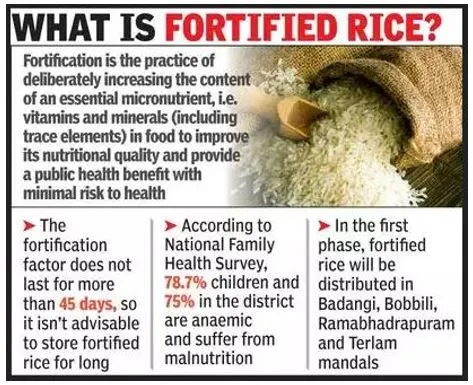

18th October 2024 (9 Topics)
Context
Recently, the Indian government's initiative to implement the universal supply of fortified rice has come under scrutiny. Concerns have been raised regarding the safety of fortified rice and allegations that the approval was influenced by multinational companies. In response, the Union Food Ministry has asserted that fortified rice is a critical measure aimed at combating micronutrient deficiencies in the country.
What is Fortified Rice?
- Fortified rice refers to rice that has been enhanced with essential vitamins and minerals to address nutrient deficiencies in the population.
- This process involves adding micronutrients, such as iron, folic acid, and other vitamins, to improve the nutritional quality of rice, which is a staple food for many in India.
- Purpose: The primary goal of rice fortification is to combat micronutrient deficiencies prevalent in India, particularly among vulnerable populations such as children and pregnant women.
- Safety Considerations: Scientific evaluations conducted by various committees have indicated that fortified rice is safe for consumption, even for individuals with conditions like Thalassemia and Sickle Cell Anemia. The Ministry emphasizes that the iron content in fortified rice is minimal and poses no significant health risks.
- Implementation: The rice fortification program began in 2019 and has expanded significantly. Currently, a large network of manufacturers and rice mills across India is equipped to produce and distribute fortified rice efficiently.
- Fortified Staple food: India is giving a massive push to fortify daily staples like cereals and milk with minerals and vitamins as a solution to micronutrient deficiency.
- So far, India has developed fortification standards for rice, wheat, edible oils, salt and milk.
- Science behind rice fortification:
- Under the fortification scheme, milled broken rice is ground to dust and a premix of vitamins and minerals is added to it.
- Thereafter, an extruder machine is used to produce fortified rice kernels (FRK) resembling rice grains.
- The kernels are then mixed in a 1:100 ratio with regular rice to produce fortified rice. The cost to the consumer is estimatedto be less than 50 paisa per kg.
- Rice kernels can be fortified with several micronutrients, such as iron, folic acid and other B-complex vitamins, vitamin A and zinc.


